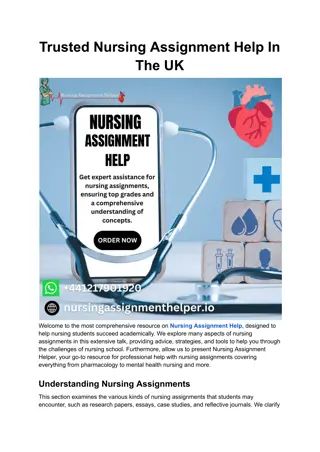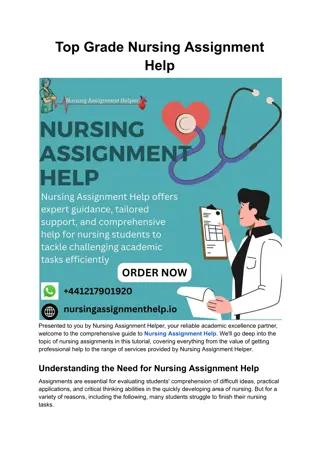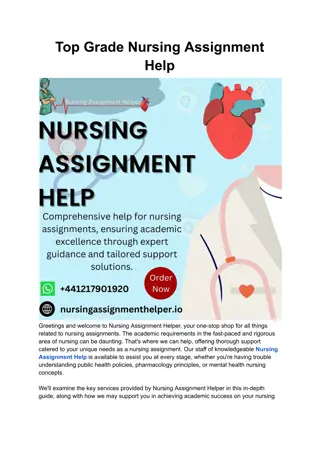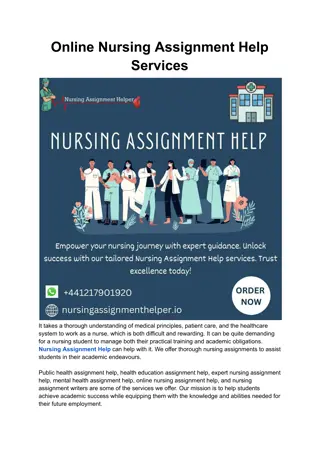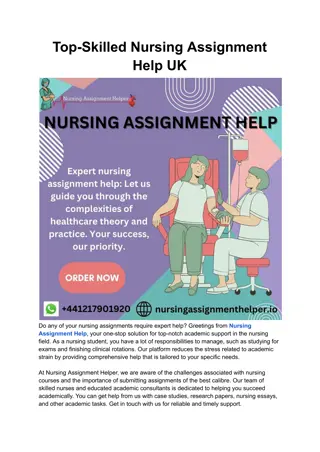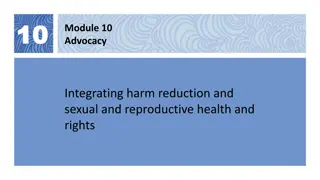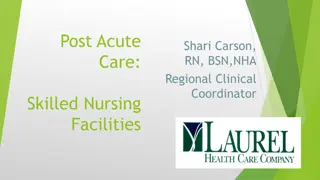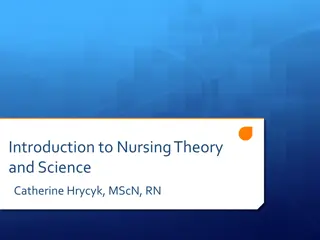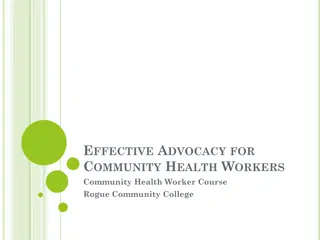
Advocacy for Better Healthcare in the USA by Catherine Hrycyk
Catherine Hrycyk, MScN, RN, advocates for better healthcare in the USA, highlighting issues such as lack of universal access, high costs, and the importance of health promotion, prevention, diagnosis, treatment, and rehabilitation in healthcare services.
Uploaded on | 3 Views
Download Presentation

Please find below an Image/Link to download the presentation.
The content on the website is provided AS IS for your information and personal use only. It may not be sold, licensed, or shared on other websites without obtaining consent from the author. If you encounter any issues during the download, it is possible that the publisher has removed the file from their server.
You are allowed to download the files provided on this website for personal or commercial use, subject to the condition that they are used lawfully. All files are the property of their respective owners.
The content on the website is provided AS IS for your information and personal use only. It may not be sold, licensed, or shared on other websites without obtaining consent from the author.
E N D
Presentation Transcript
Healthcare in USA / Advocacy for Better Care and Advancement of Profession Catherine Hrycyk, MScN, RN
USA Healthcare System Dominated by private insurance Lack of universal access: The only developed country without universal access Large fraction of population under- and uninsured High costs of care: Availability of of the most advanced technologies 17.6% of GDP (highest in the world) Outcomes lagging in spite of high costs Other healthcare systems have better outcomes with much less spending 2
Categories of Health Care Services 1. Health promotion 2. Illness prevention: I. II. III. Tertiary Primary Secondary 3. Diagnosis and treatment 4. Rehabilitation and long-term care 3
Health Promotion and Maintenance Goals: Remain healthy Prevent diseases and injuries Promote healthier lifestyles 1. 2. 3. Assumption: Patients who adopt healthy behaviors are more likely to avoid certain illnesses These services require patients active participation. 4
Prevention Illness prevention services address health problems after risk factors are identified Three levels of prevention: Prevention of disease Early detection III. Prevention of complications and/or disability I. II. 5
Diagnosis and Treatment Modern technology helps refine methods of diagnosing and managing illnesses Examples: Imaging and detection of cancers Minimally invasive surgery High-technology services can lead to dehumanization of patients 6
Rehabilitation and Long-term Care Rehabilitation services help restore the patient to the fullest possible level of function and independence after injury or illness Rehabilitation with disease management services focus on helping patients understand and manage chronic conditions Long-term care provides services that the patient or family cannot provide but at levels that maintain individual independence as long as possible 7
Health Care Agencies Government or voluntary agencies Federal agencies State agencies Local agencies Voluntary (private) agencies and non-government organizations Not-for-profit or for-profit agencies 8
Level of Services Provided Primary care services when the patient first enters the health care system Examples Goals Entry into the system 1. Emergency care 2. Health maintenance 3. Management of long-term and chronic conditions 4. Treatment of temporary health problems that do not require hospitalization 5. 9
Level of Services Provided Secondary care services management of a condition by a specialist after being referred by a primary care provider. Examples: Tertiary care services provided to acutely ill, those requiring long-term care, those needing rehabilitation services, and the terminally ill Examples Quaternary care research facility. Uncommon. 10
Level of Services Provided Subacute care services goal-directed, comprehensive, inpatient designed for acute illness, injury, or exacerbation of disease process Goal: Provide lower cost health care and create a seamless transition of patients moving through the health care system 11
Health Care Disparities: A Continuing Challenge Health care disparities are differences in access to and the quality of health care provided to different populations. Causes of disparities Race, ethnicity, gender, age, income, education, disability, sexual orientation, and rurality Provider bias (Agency for Healthcare Research and Quality, 2013) 13
Nurses Role on the Health Care Team Provider of care Educator Manager Researcher Collaborator Patient advocate 14
Advocacy for Better Care and Advancement of Profession Power, Authority, and Influence Power strength or force that is exerted or capable of being exerted Authority legitimacy to exert power Influence process of producing effects on action, behavior, and opinions of others Examples? 15
Policy Health policy private or public rules, regulations, laws, or guidelines that relate to the pursuit of health and delivery of health services Policy decisions reflect the values and beliefs of those making the decisions Public officials act on the interest of their constituents to support passage of laws and development of policies. Professional organizations 16
Politics Politics is a process of influencing the allocation of resources Policies are decisions Politics influences those decisions. Stakeholders individuals with vested interest Example: To increase funding for nursing scholarships, stakeholders lobby state legislators. 17
Linking Practice, Policy, and Politics Florence Nightingale worked with Sir Sidney Herbet, Secretary of War Lavinia Dock found ANA, pressured hospital administrators to improve working conditions, and galvanized support for nursing licensure (Lewenson, 2007). Karen Daley and needle stick injury influence public officials to make nursing practice safer. 18
How Policy Influences Nursing Practice Laws define nursing practice Periodic need to influence lawmakers to modify the nurse practice act to reflect current clinical practice NPs reimbursement, autonomy, and prescription writing FDA sets rules for administering and documenting the administration of narcotics. Need to influence legislators regarding broader issues like pay equity, staffing ratios, etc. 19
Professional Organizations Nurses join organizations to Network with colleagues Pursue continuing education and certification opportunities Stay informed on professional issues Develop leadership skills Influence health policy Work collectively for job security 20
Professional Organizations Reasons why nurses do not join organizations: high cost of dues, lack of time, and lack of interest Less than 10% nurses are members of ANA. Only 20% nurses belong to a specialty nursing organization. Types of organization Broad-purpose professional organizations Specialty practice organizations Special interest organizations 21
Professional Organizations The mission statement is generated by the membership and defines the organization s purpose and goals and who is served by the organization. ANA Mission Statement: Nurses advancing our profession to improve health for all ANA Goals: fostering high standards of nursing practice, promoting the rights of nurses in the workplace, projecting a positive and realistic view of nursing, and by lobbying the Congress and regulatory agencies on health care issues affecting nurses and the public 22
Nurses and Unions Nurses may choose to join unions to Work collectively Have control over their practice and workplace Work to equalize power between management and staff National Labor Act and overseen by National Labor Relations Board Issues in contract negotiations: staffing, work assignments, and shared governance 23
Nurses and Unions Nurses wonder whether they should join unions. Closed shop the management is required to bargain with the union and union membership is required as a condition of employment. Open shop employees are not required to join but in which an individual s contract will be dependent on what the union and management have negotiated. Right to work states the value system of work culture is less supportive of union affiliation. 24




